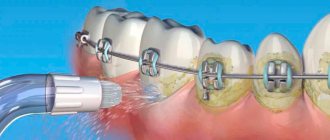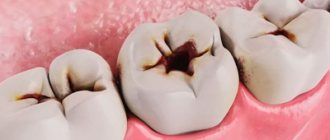- Causes of fillings falling out
- How long can you walk without a filling and what to do if it falls out?
- If a temporary filling falls out
- What to do if a filling falls out during pregnancy?
- Prevention
Before visiting the dentist, many patients experience, if not fear, then at least anxiety.
Therefore, when we leave the office with a new filling, we breathe a sigh of relief. Now you can eat and smile normally. What a disappointment if the filling falls out. Why does this happen and can it be avoided?
Question No. 1: why can fillings fall out and who is to blame for this?
If a filling falls out of a tooth, the dentist who performed the treatment or the patient himself may be to blame. Such an unpleasant situation could occur many years after treatment or after a short period of time. Let's look at the main reasons why this could happen.
What mistakes could the dentist make:
- the doctor made an incorrect diagnosis and carried out the wrong treatment: for example, a filling flew out of a tooth because the dentist treated caries, although the patient had pulpitis. Due to the incorrect actions of the doctor, the source of inflammation in the tooth will remain under the filling, and serous fluid will form in the canals or pus will appear, which after a certain period of time will simply displace or squeeze out the filling,
- The doctor did a poor job of preparing hard tissues: before applying the material, the dentist must align the tissues. If the work was not done well enough, the chewing load may subsequently be distributed unevenly, and the artificial material will crack and fall out,
- non-compliance with proportions when mixing filling material,
- use of low-quality or expired materials,
- poor drying of the oral cavity at the time of treatment: saliva, as well as any liquid in the mouth, can weaken the properties of adhesive compounds,
- insufficient polymerization time for materials,
- excess filling material: if it extends beyond the bite, it will cause discomfort. In addition, when chewing food, it will be subject to excessive stress, which will lead to cracks and chips, and patients will then wonder why fillings fall out of their teeth,
- inappropriateness of restoration: for example, the tooth was destroyed by more than half, and it would be more appropriate to install an inlay or crown on it.
Mistakes made by the dentist during installation can cause it to fall out
. What should you do if a filling falls out? You shouldn’t immediately blame only the dentist for everything, because the patient himself may be involved in the current situation. Here are the reasons why this situation can happen:
- the patient began to eat earlier than 2 hours after treatment: do not be surprised that the filling fell out just a couple of days after visiting the dentist, if you did not wait the required 2 hours after its installation and began to put increased stress on the material, which has not yet hardened enough ,
- you periodically eat the “wrong” foods: nuts, crackers, chewing gum or sticky sweets (taffy), which again put an increased load on the filling materials,
- internal diseases of the body: for example, cardiovascular and endocrine, as well as hormonal pathologies lead to circulatory disorders. As a result, the nutrition of the tooth and surrounding tissues deteriorates. The tooth itself becomes weaker, it begins to crack, and the quality of fixation of the composite and photopolymer material weakens.
Sticky candies and chewing gum can damage the filling.
“Five years ago I had all my teeth fixed and had fillings put in. The other day one of them fell out and I ran to the dentist. Of course, the doctor looked at me with strange eyes and said that in general this was normal, because its expiration date had simply expired, the properties of the materials and adhesive glue had disappeared, and there was nothing to be surprised about. But really, the dentist is probably right, I somehow didn’t think about it - I thought that the filling would last forever...”
ErinKa, review from the dental portal gidpozubam.ru
Classification of dental fillings and their reliability
Depending on the purpose, the filling can be temporary or permanent. The first one is placed for a period of several days to a month, depending on the purpose, then it is replaced with a permanent one. We have compiled a table in which we described the possible composition of permanent fillings, briefly described them and indicated their service life. After the specified period, they usually fall out.
| Filling material | Compound | a brief description of | Minimum service life (in years) |
| Amalgam | Silver, tin, zinc, copper and mercury. | Cheap type, used extremely rarely. Safety of use for the body has not been proven. | 10 |
| Composite | Resins with ceramic or porcelain filler. | Over time, the material shrinks, that is, decreases in volume. To avoid this, the doctor fills the crown in layers, which increases the work time and, accordingly, the cost of treatment. | 5 |
| Gold | Alloy of gold particles with other metals | More reliable, but more expensive than other types. Very noticeable. | 15 |
| Light polymer (photopolymer) | A mixture of polymers and binders. | The most common type. Very durable. When filling, the doctor very precisely adjusts the shape to the size of the cavity, so the composite is securely fixed. | 7 |
| Glass ionomer | A mixture of acrylic resin, fluorine and glass-like filler. | It fits tightly to the tooth, so the risk of recurrent caries is virtually eliminated; fluoride particles strengthen dentin. But cracks and damage occur more often in it compared to photopolymer. | 5 |
We have briefly described the advantages and disadvantages of each type so that readers do not think that the fillings with the longest service life are the best. Each material has its own characteristics; only the doctor decides which one will be effective in a particular clinical case.
Question No. 2: is it possible to prevent hair loss?
In order not to think about what to do if a filling falls out of a tooth, try to prevent this situation. First of all, choose a clinic and a doctor whose quality of work you can be 100% sure of.
Read the article on the topic: TOP 30 dental clinics that really provide quality services.
But be careful yourself. First, follow your doctor's recommendations regarding oral hygiene and nutrition. Secondly, attach importance to any alarming symptom: the appearance of a sore throat, painful sensations and chips, the formation of cracks and changes in the shade of the filling material, the material moving away from the walls of the tooth - all these are reasons to contact the dentist. Thirdly, undergo preventive examinations every six months so that the doctor assesses the situation with his professional opinion and solves the problem in a timely manner.
If you have any alarming symptoms, you should consult a specialist
Recommendations
The Doctor Martin Clinic provides services for the treatment of patients with the installation of a temporary filling, if this stage is necessary for more effective treatment. Our center provides guarantees for the work of specialists and materials, however, the possibility of temporary fillings falling out cannot be ruled out.
To reduce the risk of opening a tooth cavity when a filling falls out, our experts recommend:
- use low-hardness brushes for dental care;
- reduce the load on the affected tooth;
- exclude the influence of sudden temperature changes (including eating dishes of different temperatures);
- Do not touch the fillings with your tongue or any objects.
Installation of a temporary filling is a mandatory intermediate step in the treatment of many dental diseases.
Compliance with all recommendations, the professionalism of the doctor and high-quality materials reduce the likelihood of temporary fillings falling out to a minimum. If the filling does fall out, we recommend contacting our specialists for advice and making an appointment as soon as possible.
Question No. 3: what are the consequences of loss?
It often happens that a filling falls out and a tooth hurts. This may indicate the development of an infectious-inflammatory process, the formation of pulpitis or periodontitis, a cyst or abscess.
However, if the material falls out and the tooth does not hurt, then you should not leave the situation to chance. Remember that after the material falls out, the cavity remains open, defenseless against bacteria. Pieces of food may become clogged in it and will be difficult to remove with a brush. Over time, the smallest food remains can rot and again serve as an excellent breeding ground for bacteria that provoke the development of the inflammatory process.
Not only permanent restorations, but also temporary restorations that contain medicine or arsenic can fall off. Medicines can get from the open cavity into the saliva, onto the mucous membrane and into the stomach, which in some patients will cause allergies, irritation and itching of the mucous membrane or swelling, and gastrointestinal upset.
Teeth that have been treated and prepared may have rather thin and weakened walls, which will quickly begin to collapse under chewing stress. The sharp edges of hard tissues can injure the mucous membrane of the oral cavity, as well as damage the enamel of the antagonists located on the opposite jaw. If you do not see a doctor in time, you can completely lose your tooth.
The walls of the tooth are quite thin and weakened and can quickly collapse
What problems might there be?
Caries often occurs in the marginal area of tooth enamel. The vulnerability is due to the following reasons:
- A small gap forms between the dental tissue and the filling, where infections can enter.
- When preparation is carried out, a fragment of enamel is destroyed, microscopic cracks appear, and the enamel may break off.
The filling technology must be followed correctly. Saucer-shaped cavities will not hold materials as well. The dentist needs to ensure that the cavity is kept clean before filling to prevent infection.
The dentist who performed the installation will help you solve the problem of the temporary filling falling out. If a patient has doubts about his level of qualifications, he will have to look for a new doctor. The dental clinic must be licensed. Only in such institutions can you get a guarantee for your new teeth.
Question No. 4: How long can you walk without a filling?
A filling fell out: how long can you walk without it? This is one of the most pressing questions that people ask in such a situation. Here the answer will be this: you need to see a doctor as soon as possible after such a situation occurs. We must not forget that loss of tightness of artificial material can lead to the population of the tooth cavity by pathogenic microorganisms. If arsenic was placed in the cavity, then the loss of the protective barrier can lead to intoxication of the body when the substance is swallowed. In addition, if the arsenic paste is not hermetically sealed, this can lead to burns of the mucous membrane and necrosis of bone tissue, so delay here is unacceptable.
What to do if a filling falls out of a tooth
A dental filling is a composite material that fills a tooth cavity to protect it from germs and prevent dentin decay.
However, after therapy, patients may encounter a situation where the filling falls out, crumbles, or a piece breaks off. In the article Stom-Firms.ru we will talk about the service life of various fillings and describe why they can fall out. At the end of the publication, read what to do if the filling breaks or completely crumbles.
Question No. 5: Why does a tooth hurt after a filling falls out?
If a filling falls out, it often happens that the tooth hurts afterwards. What to do? Of course, consult a doctor. And there can be many reasons for the appearance of painful sensations:
- tissue reaction to external irritants: if a filling comes out, then the tooth hurts due to the fact that the exposed nerve endings began to give an acute reaction to thermal irritants, as well as to mechanical pressure during chewing food or during hygienic care. As a rule, the pain reaction quickly passes after the effect of the irritating factor is eliminated. It is worse if the pain persists even at rest - this may indicate inflammation of the nerve (pulpitis),
- infection: if a filling falls out of a tooth, and you don’t think about what to do and continue to endure pain and discomfort, then the inflammatory process can spread to the roots and even to neighboring units,
- mistakes made by the doctor during treatment: in this case, the material flies out quite quickly after visiting the dental office, and the cause of pain can be, for example, a fragment of an instrument in the root canal.
There can be many reasons for the appearance of painful sensations
How will a fallen filling be treated?
The solution to this problem is not difficult. The dentist will solve it very simply. Of course, in such a situation, everyone has many questions, such as whether the treatment is painful, or whether the tooth will be drilled. Let's look at what measures the doctor will take and how all the procedures are carried out step by step.
First, the doctor will prepare the carious cavity of the tooth. Using metal and diamond burs, the doctor will remove all tooth tissue affected by caries. This procedure requires special care, because the remains of caries can provoke its re-development. Even if the most expensive materials are used to fill such a cavity, there is no guarantee that the filling will last long. In this case, caries will continue to progress.
The second thing the dentist will do is correct formation of the dental cavity. Each material has its own requirements for the formation of a dental cavity for a filling.
Due to the doctor’s haste, many extremely important stages of restoration may be missed or carried out in bad faith, so for restoration and re-filling it is worth paying special attention to the choice of a specialist.
Question number 6: what can be done at home?
A filling has fallen out of a tooth and you don’t know what to do? First of all, rinse your mouth with a soda-salt solution. If pain occurs, take painkillers - Ketanov, Nurofen, Baralgin, Tempalgin. Any drug that is not contraindicated and in such cases brings you relief will do.
Next, you need to make an appointment with a doctor. Before going to the dentist, try not to chew on a sore tooth (this can lead to rapid destruction or pain), improve oral hygiene, use an irrigator to remove small food debris from the resulting cavity.
Painkillers can be used to relieve pain
Temporary filling with arsenic
One of the components of the filling mixture is arsenic. This method of neutralizing the dental nerve is used when other methods are impossible. The toxic substance has a detrimental effect on the nervous tissue and pulp and contributes to its destruction. This procedure is painless; the paste contains painkillers that neutralize pain.
An important rule for installing a filling with arsenic is to comply with the terms of wearing it. No more than 3 days should pass from the moment of installation. If you leave a temporary filling in longer, arsenic can harm the tooth and nearby tissues. If a temporary filling falls out prematurely, you need to contact your dentist and remove its remains, if any.
You can use a soda solution to rinse your mouth . To prepare, take a glass of boiled water, add one teaspoon of soda and a few drops of iodine. After rinsing, take a sterile swab and cover the sore tooth with a temporary filling. Then you can go to the dentist.
If there is a possibility that a fragment of a filling with arsenic has been swallowed, after rinsing with the solution, you need to drink a glass of milk to neutralize the poison.
Question No. 7: is it possible to put the filling in place yourself?
The filling fell out. What else should you do before seeing a doctor? To protect the resulting cavity from bacteria and food, you can close it yourself using a piece of cotton wool or a bandage. However, such a protective barrier will have to be changed quite often. This should be done after every snack, tea or meal. Additionally, you need to rinse your mouth with antiseptics (for example, Miramistin), herbal decoctions (chamomile and sage are suitable), and a soda solution. But you shouldn’t think about making a homemade filling, or even more so gluing it. By doing this you can only aggravate the situation and cause tissue damage or infection.
Home treatment methods
As mentioned above, it is impossible to get rid of the problem at home, and it is unreasonable to expect natural abrasion of the material.
To alleviate the condition before visiting a specialist, you need to follow certain recommendations:
- Avoid eating hard foods that require biting. The sealed unit, due to its higher location, is subject to the main load, and this is fraught with a fracture of its base.
- Eliminate hot foods from your diet. This is because such foods and drinks can cause swelling of the soft tissues, increasing the discomfort.
- For severe pain, analgesics or non-steroidal anti-inflammatory drugs can be used. However, you should not abuse such drugs, because their use is limited - no more than 5 days.
Question No. 8: how will the dentist solve the problem?
It all depends on what kind of filling you have lost. If it is temporary, which was intended to retain the medicinal composition or arsenic, then the doctor will first assess the situation. For example, if arsenic was embedded in a tooth, then it is advisable to find out whether it makes sense to re-install it or whether the nerve has already been “killed” and the cavity can be cleaned and filled. If necessary, the specialist will refill the medicine and place temporary material.
If a permanent filling was installed and it falls out, then it will be necessary to remove the remaining material, then carry out aseptic treatment of the cavity and root canals, if necessary, cure the inflammation, and then it will be possible to install a new filling.
Tip #3: When eating, cover your tooth with cotton and don't chew on it.
Remember that in the absence of a temporary filling, the internal cavity remains defenseless against bacteria and small pieces of food. If food particles get into the root canals, it will be difficult to remove them, they will begin to rot, which will lead to an inflammatory process and the need to re-treat the canals. To protect the tooth from such a problem, before eating food, apply a sterile bandage or a piece of cotton wool to the opened cavity. For the same purpose, try to chew on the opposite side of the jaw.
A temporary filling is not only a “lid” that tightly closes the medicines inside, but also protection from external influences and damage. If the material falls out, the tooth becomes vulnerable, it is susceptible to bacteria and any mechanical stress, and can chip and break off. For this reason, you should also avoid chewing food (especially hard food) on a sore tooth. The thinner the tooth walls and the larger the size of the prepared cavity, the greater the likelihood of tissue destruction.
After each meal, it is important to rinse with antiseptics to “neutralize” bacteria living in the oral cavity and wash away food debris. If this is not done, then after removing the fleece, all this may end up inside an open cavity.
Question No. 9: what should be done to make the restoration last as long as possible?
The first rule is to choose a professional doctor who will provide quality treatment and install the filling correctly.
The second rule is to avoid chewing too hard foods with the treated tooth, as well as chewing gum and sticky sweets.
The third rule is to be sensitive and attentive to the slightest changes in the condition of the filling material and the treated tooth itself. If you suspect that the restoration will soon fall out, do not delay contacting a doctor. Well, in principle, do not forget to visit the dentist once every six months - to maintain the guarantee and assess the condition of the teeth in principle.
Notice
: Undefined variable: post_id in
/home/c/ch75405/public_html/wp-content/themes/UltraSmile/single-item.php
on line
45 Notice
: Undefined variable: full in
/home/c/ch75405/public_html/wp-content /themes/UltraSmile/single-item.php
on line
46
Rate this article:
( 4 ratings, average: 4.50 out of 5)
dental fillings
- Kostina I.N., Nikolaeva A.A. Arsenic necrosis of the jaw: complications in the treatment of dental pulpitis. Problems in dentistry, 2010.
Expert “If the tooth is severely damaged, more than half of the crown, then it is necessary to evaluate the feasibility of re-installing the filling. It may be better to install a crown or stump, or strengthen the root on a pin - these solutions will allow you to restore the anatomy and functionality of the damaged area.” Orthopedic dentist Vasin Yuri Aleksandrovich
Consulting specialist
Varlamova Tatyana Vitalievna
Specialization: Dentist-therapist Experience: 5 years
The most common materials from which permanent fillings are made
In any situation, the material is selected based on the patient’s key requests and financial capabilities. A fallen filling can be replaced with a similar material or any other type of product.
Before placing a filling on a tooth, you should definitely familiarize yourself with the advantages of certain materials:
Metal. The main disadvantage of such fillings is the mercury contained in the composition, which is harmful to the body. Most often, metal fillings are used on chewing teeth, as well as in the case of subgingival defects. Often, restoring a tooth with a metal filling is recommended in situations where aesthetic appeal is not important (for example, under a crown).- Glass ionomer cement. This filling has an excellent marginal fit and is low in cost. Thanks to special additives, dental tissues are nourished with fluoride ions, which prevents caries from developing again. However, such fillings are very fragile.
- Cement. Products based on powder and special liquid also prevent the formation of repeated caries, but are not durable, as they are made from fragile material.
- Composites. Products that replaced cement filling materials. Composites differ from plastics in their filler. Composites are acrylic-containing, light-curing and epoxy resin-based.
- Light composites. Such fillings are also called photopolymer fillings. This is the most popular and popular type of material for creating dental fillings in our country. Such fillings are distinguished by their aesthetic appeal, strength and durability. In addition, photopolymer fillings are distinguished by a wide range of colors and the possibility of polishing.
Comments
The other day a temporary filling fell out, the doctor put medicine inside, which did not come out completely. Is it possible to somehow pull it out and is it worth doing? Go to the appointment only in two days.
Irina Anatolyevna (07/17/2019 at 23:35) Reply to comment
- Dear Irina Anatolyevna! You should not try to pull the medicine out of the tooth cavity with various foreign objects, as you can injure the walls of the tooth or the soft tissues surrounding the tooth. The most you can do is rinse your mouth thoroughly with antiseptics or herbal decoction, but it is best to leave the medicine where it is now. To keep the medicine inside, you can cover it with a small piece of bandage or cotton wool. It is worth changing the cotton wool periodically (in particular, after each snack), and also thoroughly clean the oral cavity of bacteria and food debris.
Editorial staff of the portal UltraSmile.ru (07/22/2019 at 09:14) Reply to comment
Write your comment Cancel reply
Tip #2: Don’t rely on recommendations from online forums
A temporary filling has fallen out and you don’t know what to do in this situation? First of all, give up the idea of taking advantage of the dangerous recommendations of some Internet users. Under no circumstances should you do the following:
- cover the resulting cavity with chewing gum: you can introduce infection inside,
- pick out the remains of the filling and the medicine inside with a needle or other sharp objects: there is a high probability of damage to the soft tissues of the oral cavity. During the manipulation, there is a risk of breaking the needle, and it will be impossible to pull out the fragment on your own, which will lead to the development of inflammation. The use of sharp objects is fraught with the exact opposite effect - you will drive deeper the remains of the medicine and bacteria from the external environment,
- put antibiotics or tablets inside yourself: this can increase the pain and worsen the condition of the pulp, dentin and surrounding tissues.
Don't pick your teeth yourself









